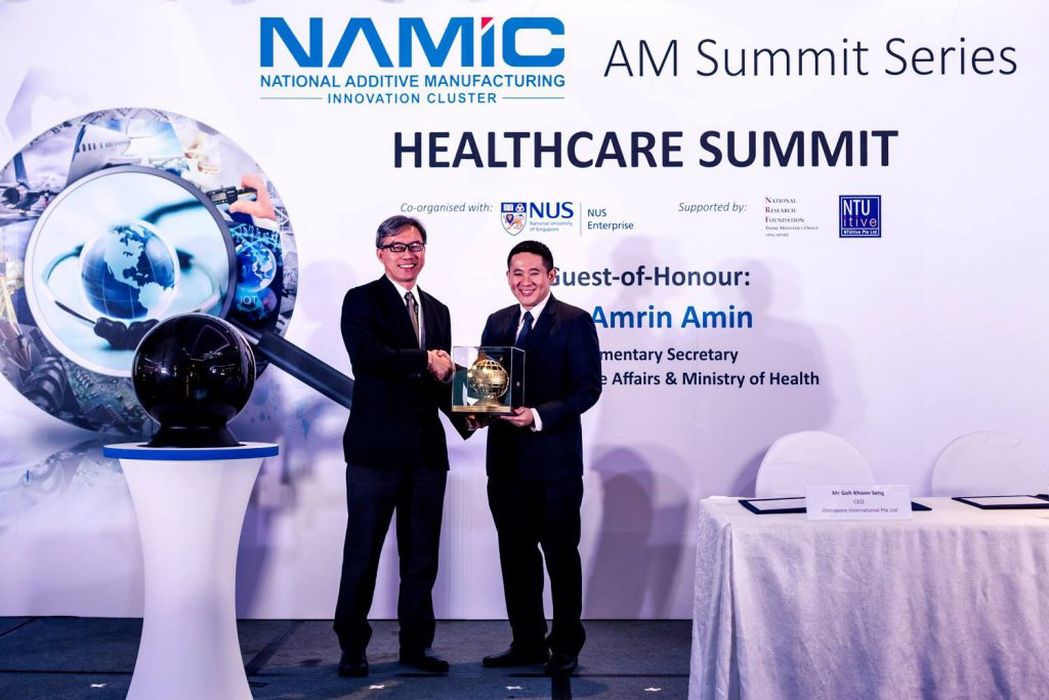
Charles R. Goulding and Preeti Sulibhavi explore how Singapore is spearheading the global 3D printing revolution, with groundbreaking innovations spanning from culinary creations to biomedical discoveries.
3D printing is rapidly transforming industries globally, and Singapore is at the forefront of this technological revolution. The city-state is leveraging 3D printing to innovate in various sectors, from food production to bioprinting. This article delves into the recent 3D printing activities in Singapore, showcasing groundbreaking examples and exploring the future potential of this technology.
3D Food Printing: The Culinary Frontier
Singapore University of Technology and Design (SUTD) has been spearheading research into 3D food printing, aiming to revolutionize the culinary landscape. The event “3D Food Printing: The Next Frontier of AM” hosted by SUTD highlights the strides made in this field. 3D food printing involves creating food items layer by layer, allowing for intricate designs and personalized nutrition.
Singapore has limited farming and livestock resources so laboratory-created meat and other foods are invaluable.
Applications and Benefits:
- Customized Nutrition: 3D food printing enables the customization of meals tailored to individual dietary needs. This is particularly beneficial for hospitals and elderly care, where patients have specific nutritional requirements.
- Sustainability: By utilizing alternative ingredients such as plant-based proteins and reducing food waste, 3D food printing promotes sustainability.
- Innovative Designs: Chefs can experiment with complex and visually appealing designs that are otherwise impossible to achieve with traditional cooking methods.
The SUTD event showcased various 3D printed food items, from intricate chocolates to personalized dietary supplements, emphasizing the technology’s potential to transform the food industry.

Bioprinting Steaks: A Sustainable Future for Meat Production
Aleph Farms, in collaboration with academic institutions, is making significant strides in the bioprinting of steak. Their research, published in a recent academic paper, details the process of creating cell-based meat using 3D bioprinting technology. This method involves printing living cells layer by layer to form a steak, closely mimicking the texture and flavor of conventional meat.
Key Highlights:
- Environmental Impact: Bioprinted steaks significantly reduce the environmental footprint compared to traditional meat production, as they require fewer resources and emit less greenhouse gases.
- Ethical Considerations: This technology addresses ethical concerns related to animal welfare, as it does not involve raising and slaughtering animals.
- Nutritional Value: Bioprinted meat can be engineered to have specific nutritional profiles, potentially offering healthier alternatives to conventional meat.
Aleph Farms’ work in Singapore represents a crucial step towards sustainable and ethical meat production, positioning the city-state as a leader in food technology innovation.
3. GOOD Meat
The Good Meat Company (“GOOD Meat”) has partnered with Huber’s to sell cultivated meat, making it the world’s first butchery to do so. With the introduction of the latest version of GOOD Meat’s cultivated chicken, the family-owned and operated business, Huber’s Butchery, is thrilled to add a new, locally produced offering to its display case and bistro menu.
“When we founded our butcher shop, we made it our mission to provide top quality and exceptional tasting meat products with the highest food safety standards at an affordable price. Partnering with GOOD Meat is in keeping with that vision and the realities of our ever-changing food system,” said Huber’s Butchery Managing Director Ryan Huber. “Cultivated meat could be one of the solutions to over-farming due to increased population size and density and an increase in animal protein consumption in many parts of the world,” added Executive Director Andre Huber.
4. Eat Just
Eat Just is so far the only company to have its cultivated, 3D printed meat product approved for public sale in Singapore, the only country to permit lab-grown meat to be sold. Its cultivated chicken product was green-lighted in 2020 and Eat Just has been working with Huber’s to offer chicken sandwiches and pasta dishes to the general public. This is with limited dining slots and once-a-week availability on the menu.
“Cultivated meat is real meat, but you don’t have to slaughter an animal,” says Josh Tetrick, chief executive of Eat Just, who spoke to the BBC from San Francisco. “This way of eating makes sense for the future,” he says.
Healthcare Innovations: 3D Printing in Medical Applications
Singapore’s healthcare sector is also benefiting from advancements in 3D printing technology. Institutions like the National University of Singapore (NUS) are exploring the use of 3D printing for medical applications, ranging from prosthetics to surgical models.
Notable Projects:
- Customized Prosthetics: 3D printing allows for the creation of customized prosthetics tailored to the patient’s anatomy, improving comfort and functionality.
- Surgical Planning: Surgeons can use 3D-printed models of patients’ organs to plan complex surgeries with greater precision, reducing the risk of complications.
- Implants and Regenerative Medicine: Research is ongoing into 3D printing biodegradable implants and scaffolds for tissue regeneration, which can help in healing damaged tissues and organs.
These innovations underscore the potential of 3D printing to enhance patient care and outcomes, marking a significant advancement in the medical field.
Industrial Applications: Transforming Manufacturing
The manufacturing sector in Singapore is undergoing a transformation with the adoption of 3D printing technology. Companies are utilizing 3D printing to enhance production processes, reduce costs, and improve product quality.
Case Studies:
- Aerospace: Singapore’s aerospace industry is integrating 3D printing for producing lightweight and durable components, leading to more efficient aircraft designs.
- Construction: The Housing and Development Board (HDB) is exploring 3D printing for building construction, aiming to reduce labor costs and construction time while increasing design flexibility.
- Electronics: Companies like HP are using 3D printing to produce electronic components with complex geometries that are difficult to achieve with traditional manufacturing methods.
These applications demonstrate how 3D printing is revolutionizing the manufacturing landscape in Singapore, driving innovation and competitiveness.

Education and Research: Fostering Innovation
Singapore’s commitment to fostering innovation is evident in its educational and research initiatives. Universities and research institutions are actively involved in advancing 3D printing technology and its applications.
Educational Programs:
- SUTD: Offers courses and workshops on 3D printing, equipping students with the skills needed to excel in this rapidly evolving field.
- NUS: The National University of Singapore (NUS) conducts interdisciplinary research on 3D printing, bringing together experts from engineering, medicine, and materials science to explore new frontiers.
Research Initiatives:
- AM.NUS: The Centre for Additive Manufacturing at NUS is a hub for cutting-edge research in 3D printing, focusing on developing new materials and processes.
- SMART: The Singapore-MIT Alliance for Research and Technology is exploring advanced 3D printing technologies and their applications across various industries.
These educational and research initiatives are crucial for maintaining Singapore’s position as a global leader in 3D printing innovation.
The Research & Development Tax Credit
The now permanent Research and Development (R&D) Tax Credit is available for companies developing new or improved products, processes and/or software.
3D printing can help boost a company’s R&D Tax Credits. Wages for technical employees creating, testing and revising 3D printed prototypes can be included as a percentage of eligible time spent for the R&D Tax Credit. Similarly, when used as a method of improving a process, time spent integrating 3D printing hardware and software counts as an eligible activity. Lastly, when used for modeling and preproduction, the costs of filaments consumed during the development process may also be recovered.
Whether it is used for creating and testing prototypes or for final production, 3D printing is a great indicator that R&D Credit-eligible activities are taking place. Companies implementing this technology at any point should consider taking advantage of R&D Tax Credits.
Conclusion
Singapore is at the forefront of the 3D printing revolution, with significant advancements in food production, bioprinting, healthcare, manufacturing, and education. Institutions like SUTD and NUS, along with innovative companies like Aleph Farms, are driving this progress, positioning Singapore as a hub for 3D printing innovation. As these technologies continue to evolve, they hold the promise of transforming industries, enhancing sustainability, and improving quality of life, ensuring Singapore remains a leader in the global 3D printing landscape.
